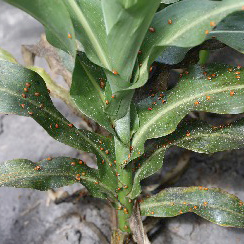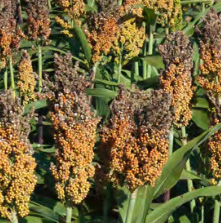Biological Control of Insect Pests
Overview
 Kansas grew more than 199 million bushels of sorghum for grain in 2014, enough to make it the highest-producing sorghum state in the nation. The invasive sugarcane aphid, Melanaphis sacchari, swept across much of the southern Great Plains in 2013 and caused serious yield losses in grain sorghum. Researchers at the Kansas State University Agricultural Research Center–Hays are working to decode nature and build and protect global food systems by identifying the natural enemies of sugarcane aphid and their roles in suppressing populations of this pest. Entomologists are assessing biological pre-adaptations of key native natural enemy species and determining the toxicity to beneficial species of novel insecticides relied upon to control sugarcane aphid. They are also evaluating possible sources of sorghum plants’ resistance to the aphids that can assist biological control and provide cross-resistance to greenbug, another economically important sorghum pest.
Kansas grew more than 199 million bushels of sorghum for grain in 2014, enough to make it the highest-producing sorghum state in the nation. The invasive sugarcane aphid, Melanaphis sacchari, swept across much of the southern Great Plains in 2013 and caused serious yield losses in grain sorghum. Researchers at the Kansas State University Agricultural Research Center–Hays are working to decode nature and build and protect global food systems by identifying the natural enemies of sugarcane aphid and their roles in suppressing populations of this pest. Entomologists are assessing biological pre-adaptations of key native natural enemy species and determining the toxicity to beneficial species of novel insecticides relied upon to control sugarcane aphid. They are also evaluating possible sources of sorghum plants’ resistance to the aphids that can assist biological control and provide cross-resistance to greenbug, another economically important sorghum pest.
Impact
 World demand for sorghum is rising. In fighting sugarcane aphids, K-State researchers are both protecting the economic interests of Kansas farmers and building and protecting global food systems as we work to feed a world population projected to reach more than 9 billion people in 2050. Biological control working in concert with host plant resistance traits in crops is the most permanent, cost-effective and environmentally friendly of all pest control solutions. This approach is known as Integrated Pest Management, or IPM. IPM aims to combine cultural, chemical and biological control tactics to protect crops and save producers money. Adopting IPM requires exploring how to accelerate the evolution of natural biological controls in managed agroecosystems such as sorghum monocultures, how to conserve beneficial species, and how to minimize the impacts of pesticide applications on nontarget species. This approach helps prevent serious economic losses and protects the environment.
World demand for sorghum is rising. In fighting sugarcane aphids, K-State researchers are both protecting the economic interests of Kansas farmers and building and protecting global food systems as we work to feed a world population projected to reach more than 9 billion people in 2050. Biological control working in concert with host plant resistance traits in crops is the most permanent, cost-effective and environmentally friendly of all pest control solutions. This approach is known as Integrated Pest Management, or IPM. IPM aims to combine cultural, chemical and biological control tactics to protect crops and save producers money. Adopting IPM requires exploring how to accelerate the evolution of natural biological controls in managed agroecosystems such as sorghum monocultures, how to conserve beneficial species, and how to minimize the impacts of pesticide applications on nontarget species. This approach helps prevent serious economic losses and protects the environment.
About Kansas State University
Kansas State University was established in 1863 as the nation’s first operational land-grant university. We’ve held firmly to the landgrant philosophy of serving our world through discovery and innovation. Today, the university is on its way to becoming a Top 50 public research university by 2025 through supporting, encouraging, and growing our research efforts.
------------------------------------------------------
Office of the Vice President for Research
www.k-state.edu/research
